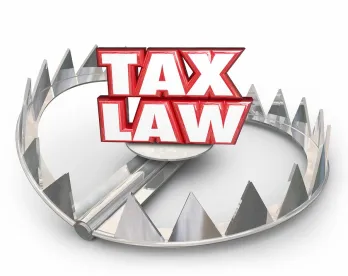Tax season is upon us. Individuals and businesses are collecting year-end tax statements and have begun the task of completing 2017 income tax returns. These returns will be filed under the “old” rules which predate the adoption of the Tax Cuts and Jobs Act that was passed by Congress and signed by President Trump in late December 2017 (the “2017 Act”). This annual tax reporting ritual may serve as an opportunity for taxpayers to consider the impact the 2017 Act will have upon their tax situation in 2018. Below is a brief summary of key provisions of the 2017 Act that will apply commencing with the 2018 tax year.[1]
INDIVIDUAL TAX LAW CHANGES
-
Individual Tax Rate Modifications
-
The 2017 Act retained seven tax brackets but adjusted them downward. Tax brackets for 2018 ordinary income under the 2017 Act will be as follows:

This represents a reduction from the prior brackets which had been at 10%, 15%, 25%, 28%, 33%, 35% and 39.6%.
-
Increased Standard Deduction and Elimination of Personal Exemptions
-
The 2017 Act increases the standard deduction from $6,350 to $12,000 for individuals and from $12,700 to $24,000 for married couples. However, the personal exemption is eliminated. The net effect is a modest increase in the overall tax savings for those taxpayers who did not previously itemize deductions. By way of example, prior to the 2017 Act, a married couple without children would have been able to claim a $13,000 standard deduction and two personal exemptions of $4,150 each (total of $8,300), resulting in an aggregate offset of $21,300.
-
The increase in the standard deduction and the elimination or limitations placed on various itemized deductions as outlined below, is expected to result in significantly fewer taxpayers who itemize deductions.
-
Charitable Deduction Implications. The 2017 Act did not eliminate deductions for charitable contributions other than those made in consideration for university seating rights associated with athletic events. Prior to the Act, charitable contributions made in consideration for the ability to purchase tickets to collegiate sporting event were 80% deductible. Deductions for contributions in consideration of such seating rights are now eliminated. While the 2017 Act made few changes to the deductibility of contributions[2] in other situations, the increase to the Standard Deduction noted above, will result in fewer taxpayers benefiting from the deductibility of charitable contributions on an annual basis. This is because a charitable deduction only provides a tax benefit to a taxpayer who itemizes deductions. Individuals who will not typically accumulate deductions in excess of the standard deduction, but who wish to obtain a tax benefit from ongoing charitable contributions, may wish to consider “bunching” deductions for multiple years into a single tax year or utilizing donor advised funds. A donor advised fund permits a taxpayer to make a large donation into a fund that will be used to facilitate contributions to donor recommended charities in the future. The contribution to the donor advised fund is deductible when made notwithstanding the fact that charitable distributions may be made over time.
-
Child Tax Credit Modifications
-
The 2017 Act increases the child tax credit from $1,000 for each qualifying child (under age 17) to $2,000. More significantly, it increases the income threshold at which the availability of the credit will phase out to $400,000 for married taxpayers and $200,000 for others. The combined effect of these changes could result in significant savings for taxpayers with large families. The tax credit is refundable up to $1,400 per child.
-
Limitations on State and Local Tax Deductions
-
The deduction for state and local taxes (“SALT”) unrelated to a trade or business has been limited to $10,000 per year for both married[3] and unmarried individuals. This limitation may be significant for taxpayers living in states with high levels of income, sales and/or property tax, but could be somewhat offset by reductions in alternative minimum tax (AMT) for taxpayers previously paying AMT due to large SALT deductions.
-
Modifications to the Individual Alternative Minimum Tax
-
Despite efforts to eliminate the alternative minimum tax (AMT) for individual taxpayers, the AMT has been retained. The 2017 Act, however, increased the exemption to $500,000 for single taxpayers and $1 million for couples. This increase in the exemption and the limitation placed upon deductibility of state and local taxes, is expected to result in far fewer taxpayers being subject to the individual AMT.
-
Mortgage Interest and HELOC Limitations
-
Home mortgage interest for debt incurred to acquire or improve a residence incurred after December 15, 2017, is limited to the interest on $750,000 of principal. This applies to first and second residences but represents a decrease from the prior $1,000,000 principal limitation. Debt incurred prior to December 15, 2017, is grandfathered.
-
Interest related to home equity lines of credit (HELOC) loans will no longer be deductible, regardless of when incurred, unless funds are used for home improvement or acquisition.
-
Kiddie Tax
-
For many years, the Internal Revenue Code has imposed special rules of taxation on the unearned income of children under age 18, as well as certain other dependent children under age 24. If triggered, portions of the unearned income were subject to taxation at the parents’ (typically higher) rate of tax. The Kiddie Tax continues under the 2017 Act, but with the imposition of tax at a fixed rate equal to those imposed on trusts and estates rather than at the parents’ tax rate. The newly applicable rate tables will often result in a larger tax burden than under the old rules.
-
Education Modifications
-
Despite much discussion regarding the elimination of various education tax credits, each of the credits (American Opportunities, Lifelong Learner) lives on, as does the deduction of student loan interest. At the end of the day, the most significant change may be the expanded use permitted under Section 529 accounts (known as Edvest in Wisconsin). For tax years beginning in 2018, the definition of “Qualifying Distributions” will now include tuition at public, private or religious elementary or secondary schools, limited to $10,000 per student during any taxable year. This greatly expands the potential use of Section 529 accounts. However, it is important to note that the 2017 Act only affects the federal tax treatment. States are reviewing the impact of the federal change to determine whether they will adopt a similar approach and whether legislation is required to implement such a change at the state income tax level.
-
Estate and Gift Tax
-
The 2017 Act maintains the pre-Act estate and gift tax scheme but doubles the exemption previously available to taxpayers. This results in a federal estate and gift tax exemption of $11.2M per person through December 31, 2025. Estates of decedents dying after December 31, 2025, will be subject to prior levels of taxation which impose tax at the rate of 40% for amounts exceeding $5.6M (subject to indexing). The presence of a much larger gift tax exemption through the end of 2025 may present gift planning opportunities for high net worth individuals whose estates could be subject to increased taxation in the event of death after 2025.
-
Individual Health Mandate
-
The 2017 Act eliminates the individual health care mandate penalty tax that was imposed by the Affordable Care Act (“Obamacare”) beginning in 2019. Note that the penalty tax remains in effect for calendar year 2018.
CORPORATE TAX LAW CHANGES
-
Corporate Tax Rate Modifications
-
The corporate tax rate is now a flat 21% tax rate (rather than graduated rates from 15% to 35%).[4] This significant change in the tax code will compel many pass-through entities (sole proprietorships, partnerships, limited liability companies, or S corporations) to consider electing to be taxed as corporations, rather than at the tax rates for individuals.
-
Treatment of Business Income of Individuals, Trusts, and Estates
-
The 2017 Act adds Section 199A of the Internal Revenue Code (“Section 199A”), which provides for tax favored treatment of business income from pass-through entities. Section 199A addresses the wide discrepancy of the top rates at which business income would be taxed, depending on whether a business is taxed as a corporation or pass through entity. This section allows for individual taxpayers to deduct up to 20% of “qualified business income” derived from a “qualified trade or business”. This deduction is available to individuals who itemize as well as individuals who claim the standard deduction.
-
Deduction for Qualified Business Income (IRC §199A)
The Section 199A deduction is limited at the lesser of (1) 20% of qualified business income or (2) the greater of 50% of taxpayer’s allocable share of the W-2 wages paid in respect of such qualified trade or business or (b) the sum of 25% of taxpayer’s allocable share of the W-2 wages paid in respect of such qualified trade or business plus 2.5% of the unadjusted basis immediately after acquisition of qualified property used in such qualified trade or business. The total amount of the Section 199A deduction claimed in any taxable year cannot exceed the taxpayer’s taxable income (less net capital gain) for the year.
-
Qualified Business Income ("QBI”) includes the net domestic business taxable income, gain, deduction, and loss with respect to any qualified trade or business. QBI specifically excludes investment-type income such as dividends, investment interest income, short-term and long-term capital gains, and similar items. QBI also excludes reasonable compensation of a taxpayer in the case of an S corporation. In the case of a partnership, it excludes guaranteed payments for services and payments to a partner outside of his or her capacity as a partner. A taxpayer who has a net loss when computing QBI, can carry the loss forward and treat it as a loss from a qualified trade or business in the following year.
A qualified trade or business for purposes of Section 199A includes any trade or business other than a “specified service trade or business”. The deduction does not apply to specified service businesses in the fields of health, law, accounting, actuarial science, performing arts, consulting, athletics, financial services, brokerage services, or any trade or business where the principal asset of such trade or business is the reputation or skill of one or more of its employees. Furthermore, the deduction does not apply to service businesses that involve investing and investment management, trading or dealing in securities, partnership interests, or commodities. The deduction cannot be claimed if an individual is performing services as an employee.[5]
-
Qualified Business Income
-
Qualified Trade or Business
-
-
Limitation on the Section 199A Deduction
-
Exception to Section 199A Deduction Based on Income
The Section 199A deduction can be claimed by taxpayers with taxable income of less than $157,500 (or $315,000 in the case of a joint return) without regard to the nature of their business and without regard to wage or asset based limits. However, limitations on the Section 199A deduction are phased in as taxable income increases above those income thresholds. Limitations on the Section 199A deduction become fully applicable to individuals with taxable income that exceeds $207,500 (or $415,000 in the case of a joint return).
-
-
Cost Recovery and Increased Expensing of Capital Assets
The 2017 Act provides for increased expensing under Section 179 of the Internal Revenue Code. The limitation on immediate expensing of Section 179 “qualifying property” is generally increased to $1 million (from $500,000). The phase-out threshold for Section 179 deductions is increased to $2.5 million (from $2 million). There is also increased expensing under Section 168(k) of the Internal Revenue Code. First year bonus depreciation is increased from 50% to 100% for qualified assets.
-
Corporate Alternative Minimum Tax (AMT)
The corporate alternative minimum tax (AMT) has been repealed. However, unused AMT credit carryforwards are refundable for tax years beginning after 2017 and before 2022.
-
Business Interest Expense Limitations
-
The deduction for business interest income is limited to 30% of adjusted taxable income, for small businesses with revenues of less than $25 million. Any disallowed interest deductions can be carried forward indefinitely.
-
Net Operating Loss (NOL) Deductions
-
Net Operating Loss (NOL) deductions are limited to 80% of taxable income. The NOL carryback period has been repealed and the NOL carryforward period has been made indefinite.
-
Corporate Dividends
-
The 2017 Act reduces the 70% and 80% Dividend Received Deduction (DRD) to 50% and 65%, respectively, for dividends that a C Corporation received from another C corporation, with the distinction in rates based upon the ownership interest of the corporation receiving the dividend.
-
Like Kind Exchanges
-
Like Kind Exchanges under Section 1031 of the Internal Revenue Code are limited to exchanges of real property and no longer apply to any other property, including personal property associated with real property.
-
Entertainment Expenses
-
The deduction for business-related entertainment is repealed. However, businesses can still generally deduct 50% of the cost of qualified meals.
-
Executive Compensation
-
The $1 million limitation on the tax deduction for executive compensation, under Section 162(m) of the Internal Revenue Code, is further restricted with the repeal of the performance-based compensation exception to this statutory limit. Covered employees under Section 162(m) of the Internal Revenue Code include the principal executive officer, the principal financial officer, and the three most highly compensated officers for the taxable year (excluding the principal executive officer or principal financial officer). In a move intended to level the playing field with non-profit organizations, the Tax Act also imposes a 21% excise tax on compensation above $1 million for each of the five highest-paid employees of a nonprofit organization.
-
Local Lobbying Expenses
-
Local lobbying expenses are no longer deductible.
Opportunities for Businesses with Changes in Corporate Taxes
Given the changes to corporate tax provisions, almost all businesses are presented with a tax advantaged environment to build and grow their respective businesses. However, particular attention should be given to the choice of business entity, to fully realize the tax advantages of the flat 21% corporate tax rate or the benefits of the Section 199A Qualified Business Income deduction. In particular, business owners will want to be mindful of the level of their taxable income and the extent of W-2 wages paid to employees, if they are to operate as a pass through entity and claim the Section 199A Deduction. Further tax saving opportunities are presented to all businesses through increased expensing, credits, and deductions. A thorough review of business entity structure and related tax advantaged business opportunities, should be undertaken in light of the new corporate tax provisions.
[1] Most of the individual changes highlighted in this article will expire December 31, 2025, at which time the 2017 tax law will once again become the law of the land.
[2] The previous limitation on deductible cash contributions to public charities has been increased from 50% to 60% of the Internal Revenue Code (IRC) defined “contribution base” which is largely tied to Adjusted Gross Income with a few modifications. More importantly to those individuals who are college sports aficionados, the 2017 Act eliminated any deduction for charitable contributions for university athletic seating rights.
[3] Married individuals filing separately are limited to a $5,000 SALT deduction. Note that this creates a marriage penalty when compared to the available $10,000 SALT deduction for unmarried persons.
[4] This change in the corporate tax rate is permanent and not set to expire, unlike the changes in the individual tax rates which expire in 2025.
[5] The Section 199A Deduction does not apply to amounts paid as reasonable compensation to shareholders as W-2 salary or guaranteed payments paid to members in a partnership. These payments to employee-owners are excluded under the definition of QBI that is subject to the Section 199A Deduction.





 />i
/>i
